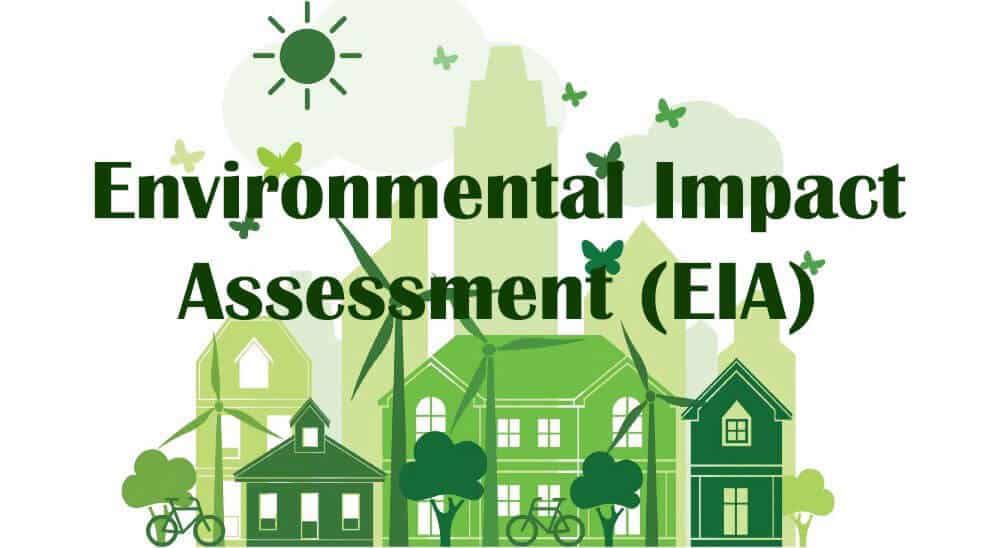What’s in today’s article?
- Why in News?
- What is EIA?
- What are the Stages of EIA?
- What are the Rules that Govern the EIA Process?
- What are the Concerns Related to the EIA?
- News Summary with respect to EIA for Urban Development Projects
Why in News?
The Supreme Court has urged legislators and policy experts to ensure that Environment Impact Assessment (EIA) studies are done before giving the green signal for urban development projects in India’s cities.
What is EIA?
- The UN Environment Programme (UNEP) defines EIA to be an analytical process that systematically examines the possible environmental consequences of the implementation of a given activity (project).
- It is aimed to ensure that the environmental implications of decisions related to a given activity are taken into account before the decisions are made.
- In India, there are 39 categories of projects that require an environmental clearance (EC) process and are subject to EIA.
- The EIA notification was first formulated in India in 1994, under the Environment (Protection) Act 1986.
- The Act made environmental clearance mandatory for expansion, modernisation of existing projects, and for the establishment of new projects.
What are the Stages of EIA?
Image caption: Objectives and Stages of EIA
- The environmental clearance process comprises four stages, namely, Screening; Scoping; Public Consultation and Appraisal.
- The Expert Appraisal Committee (EAC) is a multi-disciplinary sectoral appraisal committee, whose primary role is to give recommendations to the MoEFCC on project proposals after considering the potential impacts of the project.
- Based on these recommendations, the MoEFCC either rejects the proposal or grants a clearance with conditions which would mitigate the impacts or compensate for the same.
What are the Rules that Govern the EIA Process?
- To decentralize the process of project clearance, the EIA Notification 2006 has categorized the projects into Category ‘A’ and Category ‘B’ based on their impact potential.
- Draft EIA Notification 2020: The new draft aims to increase transparency and streamline compliance by incorporating multiple notifications, amendments, circulars, court and tribunal directions, and so on.
What are the Concerns Related to the EIA?
- Exemptions doing away with the need for green clearance:
- A time-consuming process: The EIA process, which is sometimes excessively focused on scientific investigation, takes time and causes project delays.
- There has been little public participation in the actual implementation process and the compliance monitoring following EIA is rare.
- Biodiversity is usually ignored. There is a rising awareness of the importance of including biodiversity issues in EIA.
News Summary with respect to EIA for Urban Development Projects
Background in which the recent judgement came
- In a judgment, the SC referred to media reports of how haphazard urban development has ruined the ‘Garden City’ of Bengaluru as witnessed during a major spell of rain in 2022.
- The city struggled for drinking water while it lay submerged after the downpour.
- The recent judgment came in regard to a proposal to convert independent residential units into apartments in Chandigarh Phase 1.
- The court prohibited the move in order to protect the heritage status of ‘Corbusian’ Chandigarh.
What are the SC’s observations?
- The judgment referred to a publication by the UNEP, which underscored that more than half of the world’s population is now living in urban areas.
- It is high time that the legislature, the executive and policymakers at the Centre as well as at the State make necessary provisions for carrying out EIA studies before permitting urban development.
- It is necessary that a proper balance is struck between sustainable development and environmental protection.
Way Ahead Suggested by the UNEP
- The City Development Strategies (CDSs) have shown how to integrate environmental concerns in long-term city visioning exercises.
Q1) What are the objectives of the Environmental-Impact-Assessment (EIA)?
EIA is an analytical process that systematically examines the possible environmental consequences of the implementation of a given activity (project). It is aimed to ensure that the environmental implications of decisions related to a given activity are taken into account before the decisions are made.
Q2) Which law in India governs the notification of EIA rules?
The EIA notification was first formulated in India in 1994, under the Environment (Protection) Act 1986. The Act made environmental clearance mandatory for expansion, modernisation of existing projects, and for the establishment of new projects.
Source: Environment Impact Assessment must be done before allowing urban development projects: Supreme Court
Last updated on January, 2026
→ Check out the latest UPSC Syllabus 2026 here.
→ Join Vajiram & Ravi’s Interview Guidance Programme for expert help to crack your final UPSC stage.
→ UPSC Mains Result 2025 is now out.
→ UPSC Notification 2026 is scheduled to be released on January 14, 2026.
→ UPSC Calendar 2026 has been released.
→ UPSC Prelims 2026 will be conducted on 24th May, 2026 & UPSC Mains 2026 will be conducted on 21st August 2026.
→ The UPSC Selection Process is of 3 stages-Prelims, Mains and Interview.
→ Prepare effectively with Vajiram & Ravi’s UPSC Prelims Test Series 2026 featuring full-length mock tests, detailed solutions, and performance analysis.
→ Enroll in Vajiram & Ravi’s UPSC Mains Test Series 2026 for structured answer writing practice, expert evaluation, and exam-oriented feedback.
→ Join Vajiram & Ravi’s Best UPSC Mentorship Program for personalized guidance, strategy planning, and one-to-one support from experienced mentors.
→ UPSC Result 2024 is released with latest UPSC Marksheet 2024. Check Now!
→ UPSC Toppers List 2024 is released now. Shakti Dubey is UPSC AIR 1 2024 Topper.
→ Also check Best UPSC Coaching in India

















